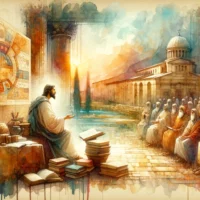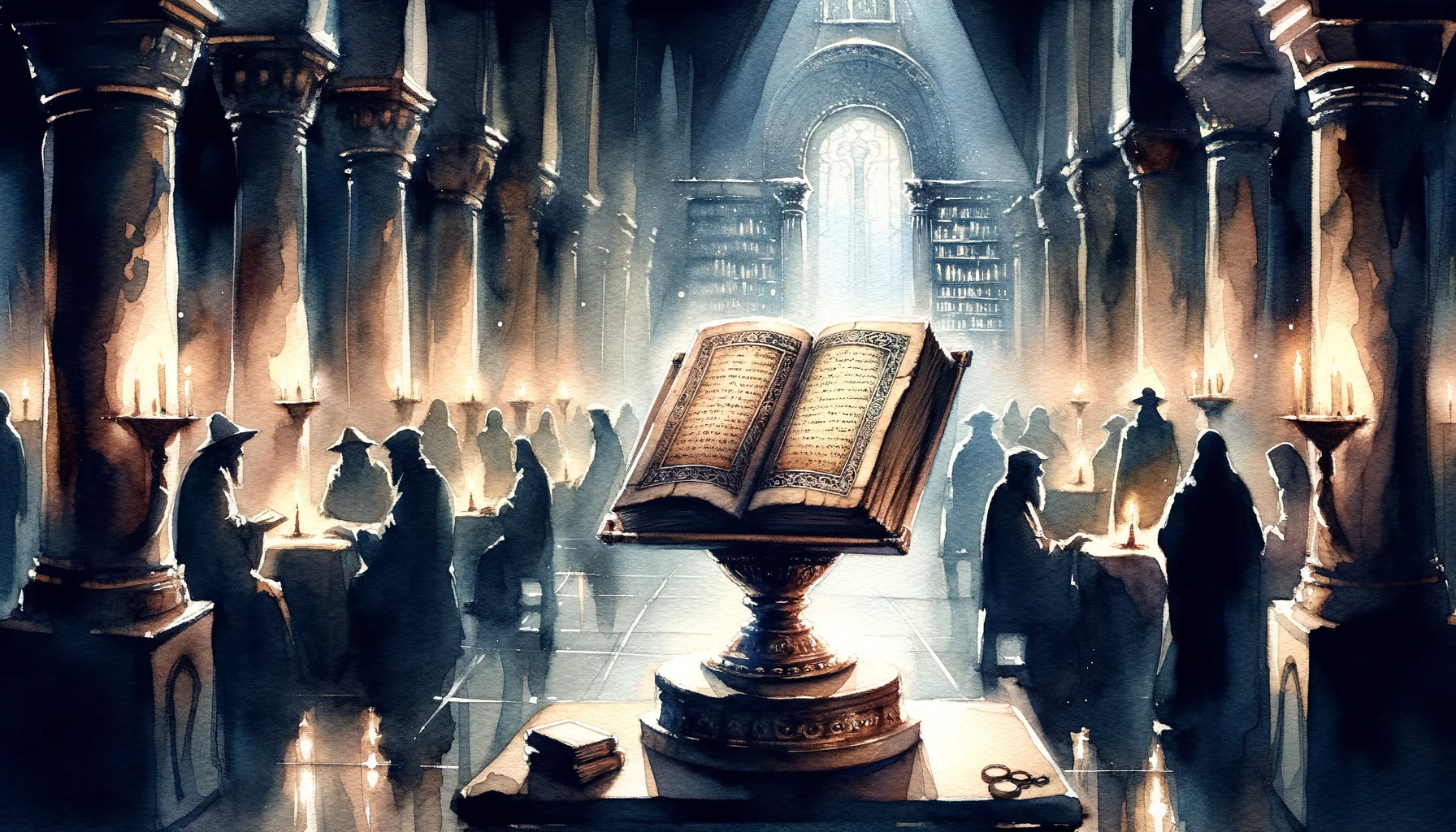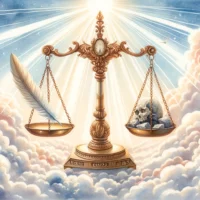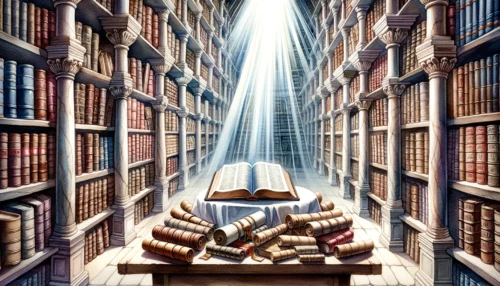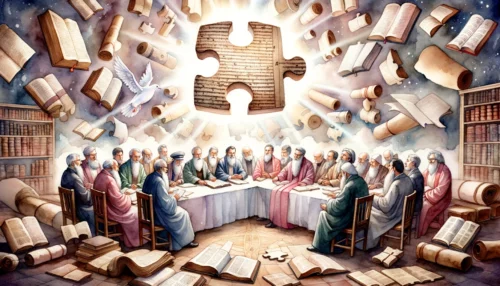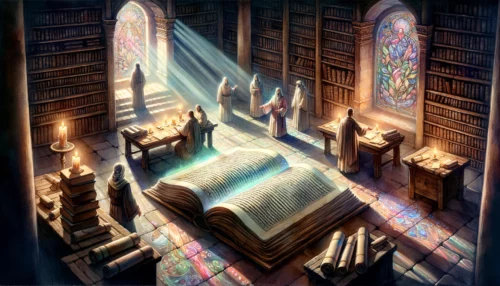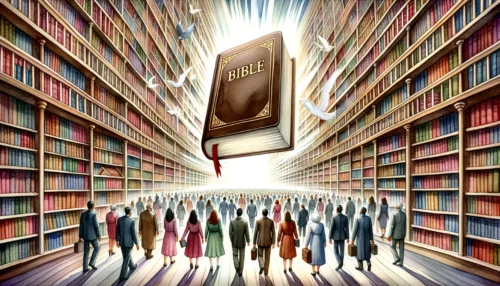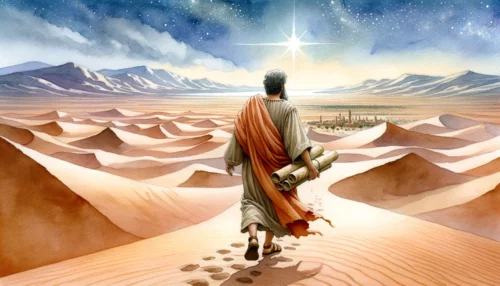With its roots in ancient Jewish literature, the Book of Enoch contains visions and revelations that some believe offer additional context to Biblical text. However, the question of its authenticity and suitability for inclusion in the Biblical canon has spurred a range of debates among theologians. Amid these discussions, we aim to better understand the Book of Enoch, its historical relevance, and its implications for contemporary Christianity.
Uncovering the Origins of the Book of Enoch
The Book of Enoch, sometimes also referred to as 1 Enoch, traces its roots back to antiquity, originating in Jewish religious thought somewhere between the third and first century BC. This timeframe situates the Book of Enoch in the Second Temple period, an era marked by significant religious development and theological exploration among the Jewish people.
The eponymous Enoch character in the book is based on the biblical figure Enoch, who is notably featured in Genesis. Genesis describes Enoch as a man who ‘walked with God’ and was taken to heaven without experiencing death (Genesis 5:21-24). This fascinating narrative sparked the imagination of many, leading to the production of additional texts centered around Enoch’s experiences, with the Book of Enoch being the most extensive of these.
There are three primary sections of the Book of Enoch: the Book of the Watchers, the Book of Parables, and the Astronomical Book. Each section presents a different focus, with the Book of the Watchers exploring angelic hierarchies and the origin of evil, the Book of Parables presenting visions of the future kingdom and final judgement, and the Astronomical Book dealing with calendrical and cosmological issues.
The manuscript tradition of the Book of Enoch is varied and complex. The book was widely known in the ancient world, with portions or summaries of the book being discovered among the Dead Sea Scrolls. These are some of the earliest and most important sources of the Book of Enoch. Interestingly, the complete text of 1 Enoch was preserved in the Ge’ez language of Ethiopia and was included in the canon of the Ethiopian Orthodox Church.
As for its non-inclusion in the Jewish and Christian canons, there are several factors at play. The language, style, and content of the Book of Enoch distinguish it from the other books that were ultimately included in the Bible. There’s evidence that early church fathers, such as Tertullian and Augustine, debated its authenticity and suitability. The book didn’t make it into the Latin Vulgate, an influential translation that played a significant role in the formation of the canon.
The Book of Enoch, also known as 1 Enoch, originated during the Second Temple period, between the third and first century BC. It’s based on the biblical figure Enoch from Genesis, and contains three main sections: the Book of the Watchers, the Book of Parables, and the Astronomical Book. Various portions of the Book of Enoch were found among the Dead Sea Scrolls, and the complete text has been preserved in the Ethiopian Orthodox Church’s canon. Despite debates among early church fathers, the book was not included in the Christian and Jewish biblical canons due to differences in language, style, and content.
Exploring the Content of the Book of Enoch
Delving into the content of the Book of Enoch, one encounters a rich tapestry of visions, prophecies, and angelic revelations. The book can be seen as divided into three major parts, each with its unique themes and narratives.
The Book of the Watchers (Chapters 1-36) introduces us to the ‘Watchers,’ angelic beings who rebel against God and descend to earth to mate with human women, resulting in a race of giants. This echoes the puzzling passage in Genesis where the “sons of God” are mentioned in relation to the “daughters of men” (Genesis 6:1-4). The Book of the Watchers also presents Enoch’s journeys through heaven and earth, guided by angels.
Next comes the Book of Parables (Chapters 37-71). This section contains three parables or visions of Enoch that focus on the future kingdom and final judgement. One of the intriguing aspects of this section is the figure of the ‘Son of Man,’ a title Jesus uses for himself in the New Testament. In the Book of Parables, the ‘Son of Man’ is depicted as a divine figure who will execute judgement and establish a kingdom of righteousness.
The Astronomical Book (Chapters 72-82) is the last primary section, focusing on the heavenly bodies’ movements and their symbolic meanings. Enoch receives detailed knowledge about the workings of the universe, celestial mechanics, and the calendar, reflecting a deep ancient interest in astronomy and cosmology.
Beyond these main parts, the Book of Enoch contains two smaller sections – the Book of Dream Visions, which narrates the history of the world from Adam to the Maccabean revolt in a series of animal allegories; and the Epistle of Enoch, a moral exhortation and prophecy of judgement.
A common thread running through the Book of Enoch is its apocalyptic nature. The visions and prophecies often speak of end times and divine judgement, subjects that resonate with the more well-known apocalyptic texts in the Bible, like Daniel and Revelation.
The Book of Enoch consists of various sections with different themes. The Book of the Watchers discusses angelic beings, their rebellion, and Enoch’s journeys. The Book of Parables includes three visions about the future kingdom and final judgement, and introduces the ‘Son of Man’. The Astronomical Book presents knowledge about the universe and celestial bodies. Other parts include the Book of Dream Visions and the Epistle of Enoch. The Book of Enoch has an apocalyptic character, speaking of end times and divine judgement.
Assessing the Role of the Book of Enoch in Christian Canon
Addressing the role of the Book of Enoch within the Christian canon requires an understanding of how the canonical books were selected. The canonization process was meticulous and carried out over centuries by early Christian leaders who were guided by several criteria. Among these were apostolic origin, widespread acceptance, and consistency with the rule of faith.
The Book of Enoch doesn’t clearly meet these criteria. There is no known apostolic origin or endorsement for the book. This differs from New Testament books, many of which are attributed to the apostles or their close associates. Widespread acceptance is also lacking for the Book of Enoch. While certain church fathers, like Tertullian, held it in high regard, others, like Augustine and Jerome, did not.
Consistency with the rule of faith is another challenge for the Book of Enoch. The rule of faith refers to the core tenets of Christianity as understood by the early Church. The Book of Enoch, while intriguing, includes content that diverges significantly from these established teachings. Its emphasis on angelology, secret knowledge, and complex cosmology are far removed from the Gospel message of salvation through faith in Jesus Christ.
Even with these challenges, the Book of Enoch is not entirely without influence in Christian tradition. Elements of its narrative can be seen echoed in certain New Testament passages. For example, the Epistle of Jude in the New Testament contains a prophecy that appears to be directly quoted from the Book of Enoch (Jude 1:14-15). Yet this doesn’t imply endorsement of the entire Book of Enoch, but rather suggests familiarity with its contents among early Christian writers.
Despite its exclusion from the Biblical canon, the Book of Enoch remains a fascinating artifact of early Jewish religious thought. Its content provides insight into a historical period of theological exploration and contributes to a broader understanding of the cultural and religious milieu that preceded the birth of Christianity.
The Book of Enoch does not meet the criteria for inclusion in the Christian canon, such as apostolic origin, widespread acceptance, and consistency with the rule of faith. Early Christian leaders held diverse views on the book, and its content diverges significantly from core Christian teachings. Nonetheless, the Book of Enoch has influenced Christian tradition to a degree, as seen in some New Testament passages, and it provides valuable historical and cultural insight into early Jewish religious thought.
A Faithful Gaze into the Ancient Mysteries
The Book of Enoch, while outside the Christian canon, is an intriguing part of our religious heritage. It reflects the dynamism and richness of the religious thought that underpinned the formation of our faith. As followers of Christ, our primary focus remains on the Gospel message, but acknowledging and appreciating the broader religious and cultural landscape of which we are a part can enrich our understanding. Just like the biblical Enoch ‘walked with God,’ we too are called to walk faithfully, ever seeking to deepen our grasp of the divine mysteries that surround us.
As you finish reading this article, consider these questions:
- What does the existence of books like the Book of Enoch tell us about the diversity of ancient Jewish religious thought?
- How can a deeper understanding of the context in which Christianity arose inform our faith today?
- How does acknowledging non-canonical texts like the Book of Enoch affect your view of the formation of the Bible?
In the stillness of prayer and in the clamour of our daily lives, may we continue to ‘walk with God’, growing in our faith, and seeking His wisdom above all else. May the curiosity that draws us to texts like the Book of Enoch guide us not towards confusion, but towards a greater appreciation of the boundless depth of our Creator’s mysteries.



